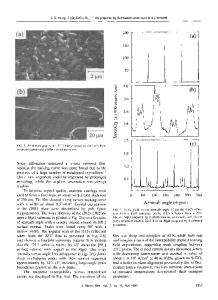Flexible Bi 2 Sr 2 CaCu 2 O 8+x tapes by metallo-organic deposition
- PDF / 1,058,625 Bytes
- 8 Pages / 576 x 792 pts Page_size
- 86 Downloads / 374 Views
The discovery of high-temperature superconductors has prompted intense research into the potential of the materials for technological application. For many commercial applications the fabrication of flexible superconducting tapes and wires is particularly important. Several processing techniques have been developed, including drawing and rolling silver-sheathed superconducting powders and sintering composite powders on a silver substrate.1"4 The thickness of the resulting oxide tapes ranged from hundreds to thousands of microns; thus their flexibility was substantially limited. Recently there were several publications describing the low temperature growth of superconducting oxide thin films on metal foils by laser ablation or magnetron sputtering.56 However, the commercial prospects of thin film techniques in this field largely depend on whether the technique can efficiently coat large areas in a reasonable length of time. Metallo-organic decomposition (MOD) is particularly attractive in this respect.7 Advantages specific to the process include accurate compositional control and potential feasibility of processing superconducting oxides into long ductile tapes by combining a web-coating or dip-coating technique. In this work, Bi2Sr2CaCu2O8+A; thin films were prepared on metal foils by the MOD process. In the MOD process the Bi2Sr2CaCu2O8+x compound possesses notable advantages in comparison with YBa2Cu3O7-^: (1) the superconducting phase forms at relatively low temperatures and requires no special post-crystallization annealing in O2,7>8 and (2) the film is highly oriented on a variety of substrates and chemically stable against moisture. It has also been reported that the critical current density of the Bi2Sr2CaCu2 oxide film exhibits a weak magnetic field dependence at low temperatures.910 Stainless steel and silver were chosen as support materials in this work. Stainless steel is economically J. Mater. Res., Vol. 6, No. 3, Mar 1991 http://journals.cambridge.org
Downloaded: 02 Apr 2015
attractive and mechanically strong. The material also exhibits high oxidation resistance at elevated temperatures. Since strong interactions between stainless steel and superconducting oxides occur at high temperatures, a suitable diffusion barrier is required to stabilize the system. Silver is inert with respect to high temperature superconductors although the material costs more than stainless steel. II. EXPERIMENTAL
A precursor used to fabricate superconducting films having a composition of Bi2Sr2CaCu2O8+;t was prepared by mixing bismuth 2-ethylhexanoate, strontium cyclohexanebutyrate, calcium 2-ethylhexanoate, and copper 2-ethylhexanoate. The bismuth precursor with a metal concentration of 20.8% was prepared in a manner similar to that described in Ref. 7. The strontium cyclohexanebutyrate and calcium 2-ethylhexanoate are- available commercially in high quality and supplied with an assay indicating a metal concentration of 19.4% and 12.3% by weight, respectively. The calcium precursor with a calcium concentration of 5% was p
Data Loading...











